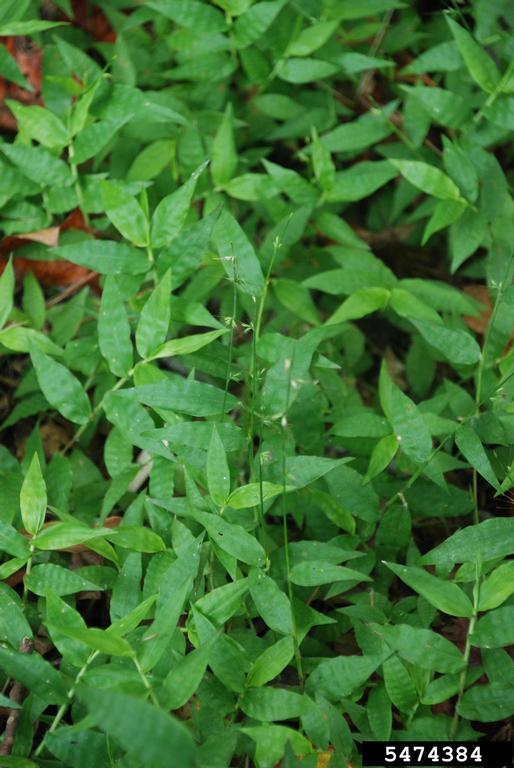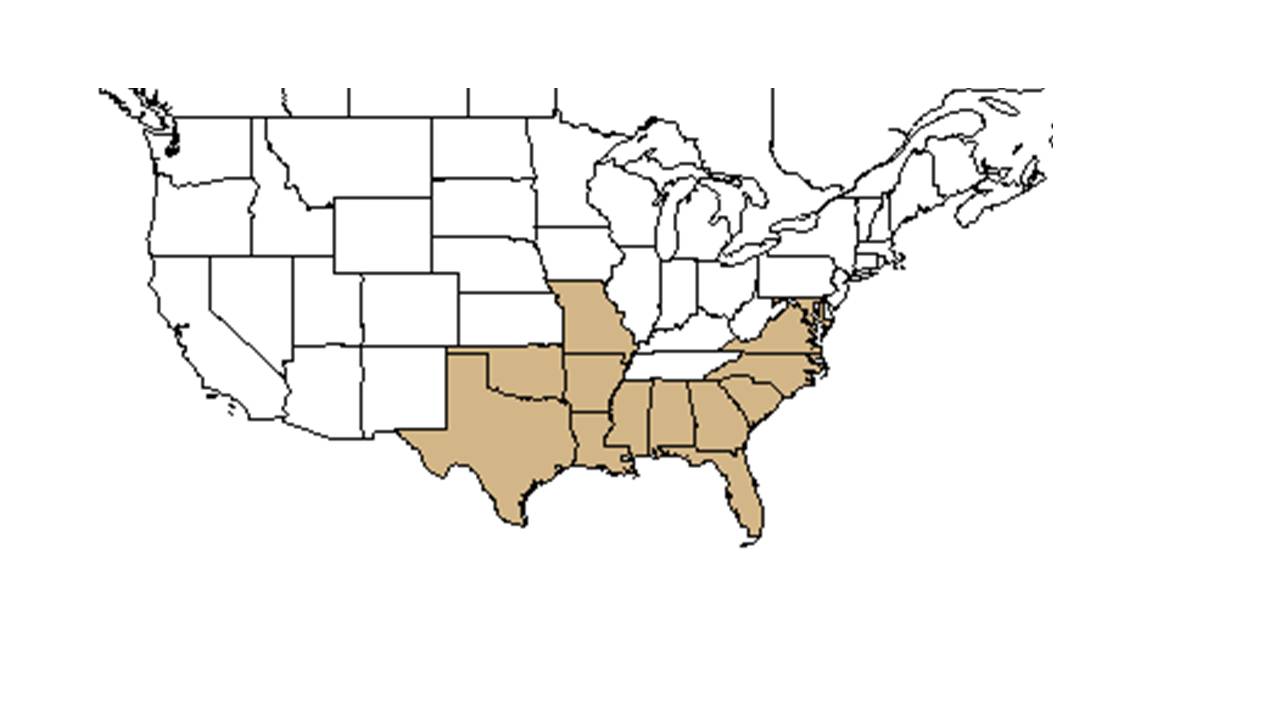Difference between revisions of "Oplismenus setarius"
Emmazeitler (talk | contribs) |
|||
| Line 18: | Line 18: | ||
}} | }} | ||
| − | Common names: Basketgrass; Woods-grass | + | Common names: Basketgrass; Woods-grass<ref name="weakley">Weakley, A.S. 2015. Flora of the southern and mid-atlantic states. Working Draft of 21 May 2015. University of North Carolina at Chapel Hill, Chapel Hill, North Carolina.</ref> |
==Taxonomic notes== | ==Taxonomic notes== | ||
| − | Synonyms: ''Oplismenus hirtellus'' (Linnaeus) Palisot de Beauvois ssp. ''setarius'' (Lamarck) Mez ex Ekman; ''O. hirtellus'' (Linnaeus) Palisot de Beauvois | + | Synonyms: ''Oplismenus hirtellus'' (Linnaeus) Palisot de Beauvois ssp. ''setarius'' (Lamarck) Mez ex Ekman; ''O. hirtellus'' (Linnaeus) Palisot de Beauvois.<ref name="weakley">Weakley, A.S. 2015. Flora of the southern and mid-atlantic states. Working Draft of 21 May 2015. University of North Carolina at Chapel Hill, Chapel Hill, North Carolina.</ref> |
==Description== | ==Description== | ||
| Line 26: | Line 26: | ||
''Oplismenus setarius'' is a perennial grass. | ''Oplismenus setarius'' is a perennial grass. | ||
| − | "Creeping perennial; upright culms 1.5-3.5 dm tall, geniculate, nodes appressed pubescent or glabrous, internodes striate, puberulent, pubescent, or glabrous. Leaves cauline; blades ovate to lanceolate, 2-6 cm long, 2-20 mm wide, upper surface densely nerved centrally, pubescent, lower surface occasionally conspicuously septate, puberulent, margins ciliate, conspicuously shorter than internodes; ligules, membranous, ciliate, 0.51-.5 mm long; collars pubescent. Panicle narrow, 2-12 cm long, 1.5-2 cm broad; strongly winged-angled, scaberulous; lateral branches 1-10, scaberulous, less than 1cm long with 1-10 spikelets, occasionally pubescent at base of branches and between spikelets. Spikelets second, ovoid to ellipsoid, 2.5-3 mm long excluding wns; pedicels pubescent, less than 0.5 mm long. Frist glume strongly scaberulous keeled, lateral nerved obscure, margins obtuse, 0.2-0.6 mm long, 2nd glume and sterile lemma 3-nerved, pubescent or glabrous, scarious, acute, 2.5-3 mm long, sterile palea absent or rudimentary; fertile lemma and palea nerveless, apiculate to mucronate, 2.5-3 mm long. Grain yellowish, oblong to ellipsoid, 2-2.2 mm long." <ref name="Radford et al 1964">Radford, Albert E., Harry E. Ahles, and C. Ritchie Bell. Manual of the Vascular Flora of the Carolinas. 1964, 1968. The University of North Carolina Press. 131. Print.</ref> | + | "Creeping perennial; upright culms 1.5-3.5 dm tall, geniculate, nodes appressed pubescent or glabrous, internodes striate, puberulent, pubescent, or glabrous. Leaves cauline; blades ovate to lanceolate, 2-6 cm long, 2-20 mm wide, upper surface densely nerved centrally, pubescent, lower surface occasionally conspicuously septate, puberulent, margins ciliate, conspicuously shorter than internodes; ligules, membranous, ciliate, 0.51-.5 mm long; collars pubescent. Panicle narrow, 2-12 cm long, 1.5-2 cm broad; strongly winged-angled, scaberulous; lateral branches 1-10, scaberulous, less than 1cm long with 1-10 spikelets, occasionally pubescent at base of branches and between spikelets. Spikelets second, ovoid to ellipsoid, 2.5-3 mm long excluding wns; pedicels pubescent, less than 0.5 mm long. Frist glume strongly scaberulous keeled, lateral nerved obscure, margins obtuse, 0.2-0.6 mm long, 2nd glume and sterile lemma 3-nerved, pubescent or glabrous, scarious, acute, 2.5-3 mm long, sterile palea absent or rudimentary; fertile lemma and palea nerveless, apiculate to mucronate, 2.5-3 mm long. Grain yellowish, oblong to ellipsoid, 2-2.2 mm long."<ref name="Radford et al 1964">Radford, Albert E., Harry E. Ahles, and C. Ritchie Bell. Manual of the Vascular Flora of the Carolinas. 1964, 1968. The University of North Carolina Press. 131. Print.</ref> |
==Distribution== | ==Distribution== | ||
| + | This species ranges from eastern North Carolina to Florida, then west to Arizona and Texas. It's also located throughout the Caribbean and Central America to central South America.<ref name="weakley">Weakley, A.S. 2015. Flora of the southern and mid-atlantic states. Working Draft of 21 May 2015. University of North Carolina at Chapel Hill, Chapel Hill, North Carolina.</ref> | ||
==Ecology== | ==Ecology== | ||
===Habitat=== <!--Natural communities, human disturbed habitats, topography, hydrology, soils, light, fire regime requirements for removal of competition, etc.--> | ===Habitat=== <!--Natural communities, human disturbed habitats, topography, hydrology, soils, light, fire regime requirements for removal of competition, etc.--> | ||
| − | ''O. setarius'' occurs in moist or wet loamy soil, from loamy humus to sandy loam. <ref name="FSU Herbarium">Florida State University Robert K. Godfrey Herbarium database. URL: [http://herbarium.bio.fsu.edu http://herbarium.bio.fsu.edu]. Last accessed: June 2014. Collectors: Ed Keppner, Lisa Keppner, Cecil R Slaughter, Loran C. Anderson, Cynthia A. Aulbach-Smith, A. Harris, J. Edmisten, R. A. Norris, R. Komarek, Robert K. Godfrey, K. Craddock Burks, Sidney McDaniel, Camm Swift, Gary R. Knight, R. Kral, Richard S. Mitchell, R. A. Pursell, _Morril, D. B. Ward, E. Pritchard, G. P. Dewolf, James R. Burkhalter, George Avery, G. Crosby, John Beckner, Sandy Thompson, Carmen Rossy-Valderama, R. L. Lazor, and E. L. Tyson. States and Counties: Florida: Alachua, Bay, Calhoun, Citrus, Dade, Escambia, Flagler, Franklin, Gadsden, Jackson, Jefferson, Leon, Liberty, Marion, Monroe, Osceola, Santa Rosa, St Lucie, Sumter, Volusia, Wakulla, and Washington. Georgia: Grady. South Carolina: Beaufort. Other Countries: Costa Rica, Panama, and Puerto Rico.</ref> It also seems to prefer partially to deeply shaded light conditions. <ref name="FSU Herbarium"/> It can be found in mesic woodlands, live oak and mixed hardwood hammocks, pine flatwoods, and situations near water, like woodland floodplains and bordering swamps or creeks. <ref name="FSU Herbarium"/> It also occurs in disturbed habitat, including trailsides, roadsides, common use areas, and railways. <ref name="FSU Herbarium"/> | + | ''O. setarius'' occurs in moist or wet loamy soil, from loamy humus to sandy loam.<ref name="FSU Herbarium">Florida State University Robert K. Godfrey Herbarium database. URL: [http://herbarium.bio.fsu.edu http://herbarium.bio.fsu.edu]. Last accessed: June 2014. Collectors: Ed Keppner, Lisa Keppner, Cecil R Slaughter, Loran C. Anderson, Cynthia A. Aulbach-Smith, A. Harris, J. Edmisten, R. A. Norris, R. Komarek, Robert K. Godfrey, K. Craddock Burks, Sidney McDaniel, Camm Swift, Gary R. Knight, R. Kral, Richard S. Mitchell, R. A. Pursell, _Morril, D. B. Ward, E. Pritchard, G. P. Dewolf, James R. Burkhalter, George Avery, G. Crosby, John Beckner, Sandy Thompson, Carmen Rossy-Valderama, R. L. Lazor, and E. L. Tyson. States and Counties: Florida: Alachua, Bay, Calhoun, Citrus, Dade, Escambia, Flagler, Franklin, Gadsden, Jackson, Jefferson, Leon, Liberty, Marion, Monroe, Osceola, Santa Rosa, St Lucie, Sumter, Volusia, Wakulla, and Washington. Georgia: Grady. South Carolina: Beaufort. Other Countries: Costa Rica, Panama, and Puerto Rico.</ref> It also seems to prefer partially to deeply shaded light conditions.<ref name="FSU Herbarium"/> It can be found in mesic woodlands, live oak and mixed hardwood hammocks, pine flatwoods, and situations near water, like woodland floodplains and bordering swamps or creeks.<ref name="FSU Herbarium"/> It also occurs in disturbed habitat, including trailsides, roadsides, common use areas, and railways.<ref name="FSU Herbarium"/> |
===Phenology=== <!--Timing off flowering, fruiting, seed dispersal, and environmental triggers. Cite PanFlora website if appropriate: http://www.gilnelson.com/PanFlora/ --> | ===Phenology=== <!--Timing off flowering, fruiting, seed dispersal, and environmental triggers. Cite PanFlora website if appropriate: http://www.gilnelson.com/PanFlora/ --> | ||
| − | + | This plant flowers from August to October.<ref name="weakley">Weakley, A.S. 2015. Flora of the southern and mid-atlantic states. Working Draft of 21 May 2015. University of North Carolina at Chapel Hill, Chapel Hill, North Carolina.</ref> | |
<!--===Seed dispersal===--> | <!--===Seed dispersal===--> | ||
<!--===Seed bank and germination===--> | <!--===Seed bank and germination===--> | ||
Revision as of 12:38, 29 September 2020
| Oplismenus setarius | |
|---|---|

| |
| Synonym Oplismenus hirtellus ssp. setarius shown, Photo by Nancy Loewenstein, Auburn University, Bugwood.org | |
| Scientific classification | |
| Kingdom: | Plantae |
| Division: | Magnoliophyta - Flowering plants |
| Class: | Liliopsida – Monocotyledons |
| Order: | Cyperales |
| Family: | Poaceae ⁄ Gramineae |
| Genus: | Oplismenus |
| Species: | O. setarius |
| Binomial name | |
| Oplismenus setarius (L.) P. Beauv. | |

| |
| Natural range of Oplismenus setarius from USDA NRCS Plants Database. | |
Common names: Basketgrass; Woods-grass[1]
Contents
Taxonomic notes
Synonyms: Oplismenus hirtellus (Linnaeus) Palisot de Beauvois ssp. setarius (Lamarck) Mez ex Ekman; O. hirtellus (Linnaeus) Palisot de Beauvois.[1]
Description
Oplismenus setarius is a perennial grass.
"Creeping perennial; upright culms 1.5-3.5 dm tall, geniculate, nodes appressed pubescent or glabrous, internodes striate, puberulent, pubescent, or glabrous. Leaves cauline; blades ovate to lanceolate, 2-6 cm long, 2-20 mm wide, upper surface densely nerved centrally, pubescent, lower surface occasionally conspicuously septate, puberulent, margins ciliate, conspicuously shorter than internodes; ligules, membranous, ciliate, 0.51-.5 mm long; collars pubescent. Panicle narrow, 2-12 cm long, 1.5-2 cm broad; strongly winged-angled, scaberulous; lateral branches 1-10, scaberulous, less than 1cm long with 1-10 spikelets, occasionally pubescent at base of branches and between spikelets. Spikelets second, ovoid to ellipsoid, 2.5-3 mm long excluding wns; pedicels pubescent, less than 0.5 mm long. Frist glume strongly scaberulous keeled, lateral nerved obscure, margins obtuse, 0.2-0.6 mm long, 2nd glume and sterile lemma 3-nerved, pubescent or glabrous, scarious, acute, 2.5-3 mm long, sterile palea absent or rudimentary; fertile lemma and palea nerveless, apiculate to mucronate, 2.5-3 mm long. Grain yellowish, oblong to ellipsoid, 2-2.2 mm long."[2]
Distribution
This species ranges from eastern North Carolina to Florida, then west to Arizona and Texas. It's also located throughout the Caribbean and Central America to central South America.[1]
Ecology
Habitat
O. setarius occurs in moist or wet loamy soil, from loamy humus to sandy loam.[3] It also seems to prefer partially to deeply shaded light conditions.[3] It can be found in mesic woodlands, live oak and mixed hardwood hammocks, pine flatwoods, and situations near water, like woodland floodplains and bordering swamps or creeks.[3] It also occurs in disturbed habitat, including trailsides, roadsides, common use areas, and railways.[3]
Phenology
This plant flowers from August to October.[1]
Conservation and management
Cultivation and restoration
Photo Gallery
References and notes
- ↑ 1.0 1.1 1.2 1.3 Weakley, A.S. 2015. Flora of the southern and mid-atlantic states. Working Draft of 21 May 2015. University of North Carolina at Chapel Hill, Chapel Hill, North Carolina.
- ↑ Radford, Albert E., Harry E. Ahles, and C. Ritchie Bell. Manual of the Vascular Flora of the Carolinas. 1964, 1968. The University of North Carolina Press. 131. Print.
- ↑ 3.0 3.1 3.2 3.3 Florida State University Robert K. Godfrey Herbarium database. URL: http://herbarium.bio.fsu.edu. Last accessed: June 2014. Collectors: Ed Keppner, Lisa Keppner, Cecil R Slaughter, Loran C. Anderson, Cynthia A. Aulbach-Smith, A. Harris, J. Edmisten, R. A. Norris, R. Komarek, Robert K. Godfrey, K. Craddock Burks, Sidney McDaniel, Camm Swift, Gary R. Knight, R. Kral, Richard S. Mitchell, R. A. Pursell, _Morril, D. B. Ward, E. Pritchard, G. P. Dewolf, James R. Burkhalter, George Avery, G. Crosby, John Beckner, Sandy Thompson, Carmen Rossy-Valderama, R. L. Lazor, and E. L. Tyson. States and Counties: Florida: Alachua, Bay, Calhoun, Citrus, Dade, Escambia, Flagler, Franklin, Gadsden, Jackson, Jefferson, Leon, Liberty, Marion, Monroe, Osceola, Santa Rosa, St Lucie, Sumter, Volusia, Wakulla, and Washington. Georgia: Grady. South Carolina: Beaufort. Other Countries: Costa Rica, Panama, and Puerto Rico.